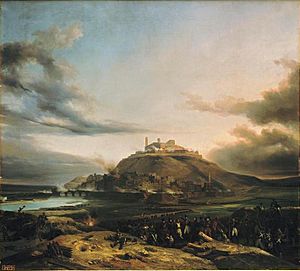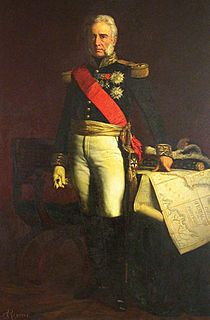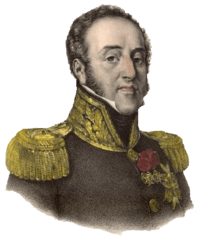Siege of Lérida facts for kids
Quick facts for kids Siege of Lérida (1810) |
|||||||
|---|---|---|---|---|---|---|---|
| Part of Peninsular War | |||||||
 A view of Lérida |
|||||||
|
|||||||
| Belligerents | |||||||
| Commanders and leaders | |||||||
| Strength | |||||||
| 13,000 | 9,000 | ||||||
| Casualties and losses | |||||||
| Lérida: 1,000 Margalef: 100–120 |
Lérida: 9,000 Margalef: 3,000, 3 guns |
||||||
The Siege of Lérida was an important battle that took place from April 29 to May 13, 1810. It was part of the Peninsular War, which was a major conflict during the Napoleonic Wars. In this siege, a French army led by General Louis Gabriel Suchet attacked the Spanish city of Lérida. The city was defended by a Spanish army under Major General Jaime García Conde.
The French army had about 13,000 soldiers, while the Spanish defenders numbered around 9,000. The siege ended on May 13 when García Conde surrendered. About 7,000 Spanish soldiers became prisoners of war. Lérida is a city located in the western part of Catalonia, Spain.
Before the main siege, there was another battle nearby called the Battle of Margalef on April 23. This battle happened when a Spanish army, trying to help Lérida, was stopped by the French. After this victory, the French used harsh methods to make Lérida surrender quickly. The fall of Lérida was the first of many successful sieges for General Suchet's army between 1810 and 1812.
Background to the Siege
In early 1810, General Louis Gabriel Suchet was in charge of the French III Corps. This army had about 23,000 soldiers, including infantry, cavalry, and artillery. Suchet originally planned to attack Lérida and another city called Mequinenza.
However, he received orders from King Joseph Bonaparte (Napoleon's brother, who was king of Spain at the time) to attack Valencia instead. King Joseph thought the Spanish armies were about to collapse. Suchet followed the order but was not happy about it. His army reached Valencia in March but did not have the right equipment to attack the city. The defenders of Valencia were also very strong. So, after only four days, the French general had to retreat.
After returning to his base in Aragon, Suchet spent some time fighting Spanish guerrillas. These were small groups of Spanish fighters who used surprise attacks against the French. Once this was done, Suchet was ready to march on Lérida.
Suchet's army arrived at Lérida on April 15. He had 13,000 soldiers and 30 cannons. The city of Lérida was a strong fortress with 105 cannons. Major General Jaime García Conde led the 8,000 Spanish defenders. García Conde was known for successfully delivering supplies to the city of Gerona during a siege in 1809.
Battle of Margalef
While Suchet was getting ready to attack Lérida, he learned that a Spanish army was coming to help the city. Suchet wanted to stop this army, so he sent a part of his forces, led by General Musnier, to intercept them. After searching for hours without success, the French turned back towards Lérida. They camped about 3 miles (5 km) from the city on the evening of April 22.
Unknown to Suchet, the Spanish relief army, led by Major General Henry O'Donnell, had managed to avoid being seen. O'Donnell's army had between 7,000 and 8,000 soldiers, including 300 cavalry and six cannons. Musnier's French division had about 5,500 men, plus 500 cavalry.
On April 23, O'Donnell's lead division, under Major General Miguel Ibarrola Gonzáles, met a smaller French force led by General of Brigade Jean Isidore Harispe east of Lérida. Harispe's small group managed to hold back the larger Spanish force until Musnier's main division arrived. When Musnier's troops appeared, Ibarrola's division quickly retreated.
At a small village called Margalef, the Spanish tried to fight off the French. But then, the French 13th Cuirassiers (heavy cavalry) charged into their side. Ibarrola's division broke apart, and the French cavalry attacked the fleeing Spanish soldiers. Just as this fighting ended, O'Donnell arrived with his second division. The Spanish general quickly turned back, but the French cavalry chased his soldiers. Again, the cuirassiers caught up and attacked the Spanish rear guard, causing more losses.
In the Battle of Margalef, O'Donnell's army lost about 500 soldiers killed and wounded. The French also captured 2,500 prisoners, three cannons, and four flags. The French lost only about 100 men, mostly from the 13th Cuirassiers. Some reports say 3,000 Spaniards were captured and French losses were 120 men.
The Siege of Lérida
After defeating O'Donnell's army, Suchet surrounded Lérida and demanded that the city surrender. However, García Conde, the Spanish commander, refused.
Lérida was located on the west bank of the Segre River. It had a bridgehead (a fortified area protecting a bridge) on the east bank. A hill to the north had a strong citadel (a fortress), and another hill to the south had Fort Garden and two smaller forts. The northern wall between the citadel and the river was known to be weak.
Suchet placed some of his soldiers and most of his cavalry on the east bank of the river to watch for any other Spanish relief forces. His other troops faced the northern and western walls on the west bank. A temporary bridge connected the two parts of the French army. The official siege began on April 29. Suchet brought up his heavy siege cannons, and by May 7, they began firing.
Lérida's defenses could not stand up to Suchet's powerful artillery. The French cannons heavily damaged the Carmen and Magdelena bastions (parts of the city walls). Within six days, the siege cannons created a large hole in the wall. Meanwhile, the French also attacked the forts on the southern hill. After one failed attempt, the French took control of the two smaller forts on the night of May 12-13.
Late on May 13, French attack groups rushed through the hole in the wall and captured it. The Spanish defenders had built a new line of defense behind the hole, but the French broke through these defenses too. At this point, García Conde ordered his soldiers to retreat into the citadel.
To pressure the Spanish commander, Suchet ordered his soldiers to gather civilians and move them towards the castle walls. This was a harsh tactic to force a quick surrender. After the Spanish commander allowed these civilians into the citadel, the French began firing shells high into the air, which then fell inside the castle. These shells killed many of the 500 civilians who died during the siege. Seeing the terrible situation, with shells hitting both soldiers and civilians inside the castle, García Conde asked for terms of surrender at noon on May 14.
The surrender meant that 7,000 Spanish soldiers became prisoners. During the siege, the Spanish army lost about 1,700 soldiers killed and wounded. The French captured six Spanish generals, 307 officers, and 105 cannons. French casualties (killed and wounded) were about 1,000 soldiers.
What Happened Next
The capture of Lérida marked the start of a remarkable series of successful sieges for Suchet's army. His III Corps seemed unstoppable.
- The Siege of Mequinenza began on May 15, 1810, and the city fell on June 5.
- The Siege of Tortosa ended on January 2, 1811, with the surrender of 3,974 Spanish soldiers and many cannons.
- Suchet then led the Siege of Tarragona. After a major attack on June 28, 1811, the Spanish commander was captured, and his large army was defeated. For this important victory, Emperor Napoleon I made Suchet a Marshal of France, which was a very high military rank.
After Suchet's victory at the Battle of Saguntum on October 25, 1811, the fortress of Sagunto also surrendered. Suchet's biggest success came next: the Siege of Valencia. This siege ended on January 9, 1812, when the Spanish commander, Joaquin Blake y Joyes, surrendered with 16,270 men. Soon after, the fortresses of Dénia and Peniscola also surrendered to the French. This made Suchet the master of the entire province of Valencia.
See also
 In Spanish: Sitio de Lérida (1810) para niños
In Spanish: Sitio de Lérida (1810) para niños



